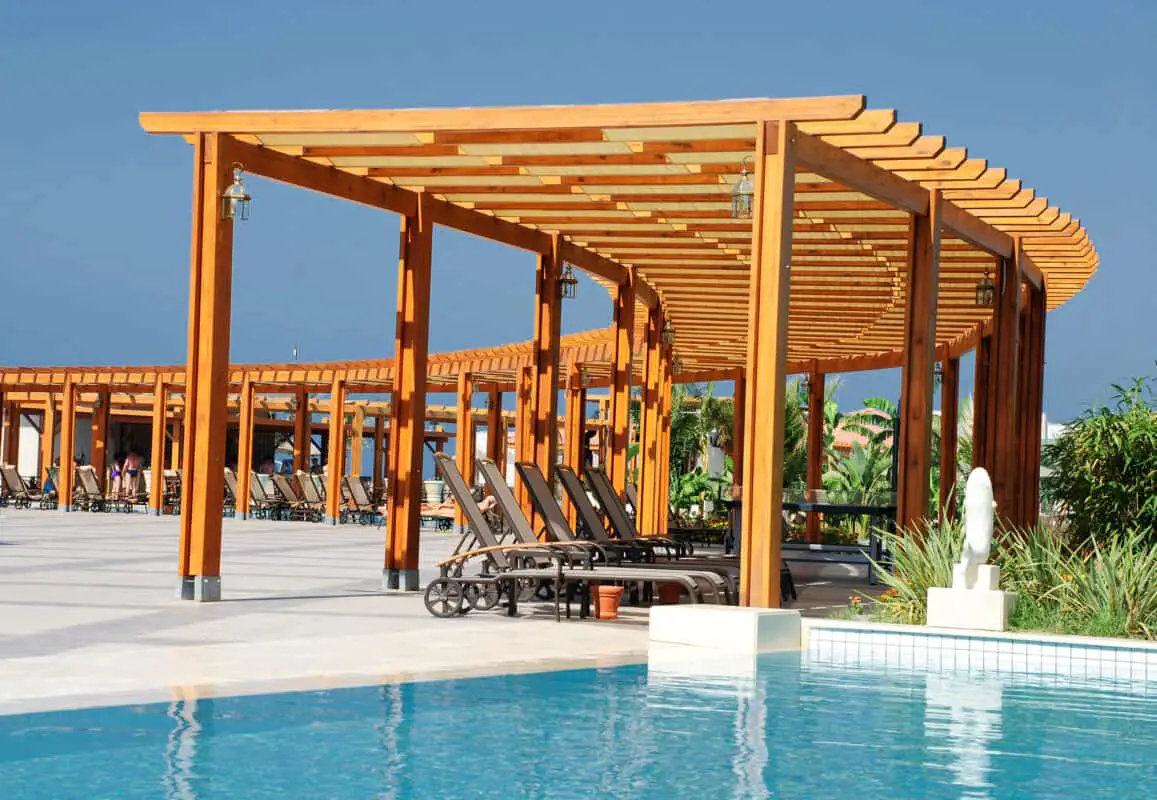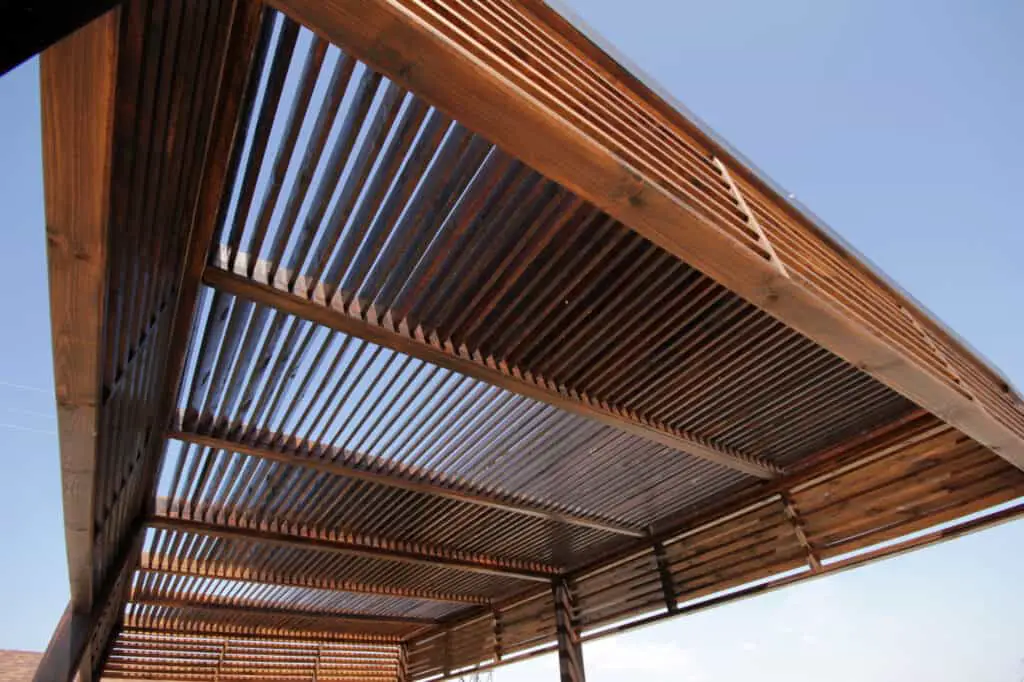A pergola with a latticed or louvered roof can offer some pergola shade coverage from the sun. You can adjust the louvered roof to reduce sun exposure.
A waterproof cover can provide the best shade coverage making the summertime experience enjoyable.
Pergolas are outdoor structures that often form an open lattice to allow air to circulate freely. This also provides some pergola shade coverage giving a better outdoor experience.
Not to be confused with arbors that are smaller and usually contain a bench with a roof, pergolas have an open air design.
Pergolas that are much larger can be used for seating areas, walkways, or passageways offering some pergola shade coverage.
Pergolas also offer an extension of a patio deck for at-home entertainment.
The structure itself is formed by vertical posts that are supported by cross-beams.
Pergolas are not meant to block out the sun entirely, instead, they offer some relief from direct sunlight.
However, there is a specific variation of a pergola called a Ramada that boasts an entirely covered roof with open sides. This variation does provide complete shade from the sun.
Homeowners are taking advantage of their outdoor space by landscaping and adding other structures, such as a pergola, that can add personality and visual appeal.
A pergola shade coverage offers an extra space for homeowners to enjoy an aspect of indoor/outdoor living to increase their usable space for entertainment.
Those who already enjoy the luxury of an uncovered patio deck may experience the woes of inclement weather like sweltering summertime sun.
A covering like a pergola with lattice can provide enough relief and light shade to make the summertime experience enjoyable.
Furthermore, to make the structure more aesthetically pleasing, some opt to decorate by adding “everything from chandeliers and ceiling fans to small speakers, strings of light, even fabric,” according to LoveYourLandcasping.org.

Table of Contents
How Much Pergola Shade Coverage is Provided?
Traditional pergolas are only able to provide 20-30% of pergolas shade coverage and do not protect against the sun or ultraviolet rays.
Some liken the experience of a pergola to sitting under a tree. While the leaves of the tree allow shafts of light to fall through, it doesn’t totally block out the sun.
While pergolas can be aesthetically appealing with their open lattices and decorative string lights, some wonder how much relief they can actually offer.
With open lattice work, there are still plenty of available spaces for sunlight to pass through reducing pergolas shade coverage.
The cross beams of the lattices provide sun protection during the day, but they will fall short of offering relief or shade when the sun’s angle is mismatched with the angle of the cross-beams.
This is also dependent on the time of year and time of day. For the most part, people want to enjoy their pergola on harsh summer days when the low angled sun is the strongest.
This can be uncomfortable if the home is located in a particularly sunny area and the surroundings are less forgiving.
When assessing a traditional pergola it’s good to keep in mind that pergolas and their lattices can vary in size.
Depending on the size of the lattice slates and the angle at which it is installed can block out more sunlight and in turn provide more pergolas shade coverage.
TemoBackyardLiving.com suggests, “ If you truly love the look of a pergola but want to get more shade out of it, then you can cover the beams with an outdoor fabric or add a climbing plant with vines that will eventually cover your top.”
Customizing a pergola could be the best option for those looking for full coverage shade.
When installing or choosing a pergola, some may want to ensure the lattices are pulled close together to ensure more shade, however, bamboo, fabric, retractable canopies, or foliage can be added.
In short, yes, pergolas can and do block the sun.
How much of the sun they block varies based on style and when the pergola is being used giving better understanding of pergolas shade coverage.
While there are many variations of pergolas that can offer complete shade, the traditional lattice or cross-beam pergolas will only offer lighter pergola shade coverage.
Advantages of Having a Pergola
Pergolas are a great way to easily add value to a home.
These beautiful structures are easy and affordable DIY projects for any homeowner looking to entice buyers or to simply enjoy more time outdoors.
With the average cost of a traditional pergola sitting at $3,600, it’s easy to understand why some may want to take this project into their own hands.
Pergolas are lattice or cross-beam structures designed to offer relief from the sun while allowing air to circulate freely.
While pergola shade coverage may not block most of the sun, there are customizing options available.
You can retrofit the cross-beams at more desirable angles or add fabric or retractable canopies for desired living enhancing pergola shade coverage.
Pergolas are a great way for anyone looking to entertain, enjoy the outdoor lifestyle, or add a unique feature to their home.
There are plenty of ways to enhance a pergola to make it feel festive or adhere to a certain aesthetics.
Designers, landscapers, architects, homeowners, and buyers are attracted to this feature to add a bit of shade to any outdoor space.
It’s been noted that since the emergence of outdoor living has skyrocketed, so has the need for appealing landscaping and additional features to add value to one’s home.
An estimated 50-80% return on investment is seen when improvements are made to the backyard space or patio area of a home.
Regardless of the pergola being professionally installed or DIY project, these structures ensure a new living space that everyone can enjoy for years to come.

Disadvantages of Having a Pergola
After installation, a pergola may require routine maintenance or treatment depending on the kind of wood used.
Over time, a pergola may need to be cleaned, painted or treated to avoid them looking weathered or succumb to the outdoor elements.
Furthermore, traditional pergolas are made from durable wood, but this could also attract termites.
During regular pergola maintenance, it’ll be especially important to look for any disturbances or activity in the wood.
While there are other material options like vinyl or bamboo, wood is traditionally used for pergolas.
Pergolas generally require maintenance like a fresh coat of paint or even termite treatment if left untouched.
If well-maintained, pergola shade coverage should continue for quite some time.
Conclusion
With plenty of options to choose from, pergolas can be completely customized.
Installing your pergola can be a fun weekend project for any DIY enthusiast.
With plenty of online resources, you should be able to find the perfect pergola project to suit your needs.
Remember to ensure your pergola is made from durable wood or another weather resistant material.
Pergola shade coverage structures will be able to last for many summers offering the best outdoor party experience.
Pergolas can also be attached to your house which can have its advantages depending on your situation.
If you are looking for complete pergola shade coverage, you may need to add a cloth canopy or close the louvered roof.
You can always opt for a different patio structure like gazebo or Ramada.
However, pergolas are an affordable option that can be changed or updated over time giving flexibility.
For those looking for slight shade and the opportunity to enhance their outdoor living, a pergola could be the solution.
I truly enjoy my pergola and have had many wonderful days entertaining family and friends.
Enjoy living the outdoor life!
